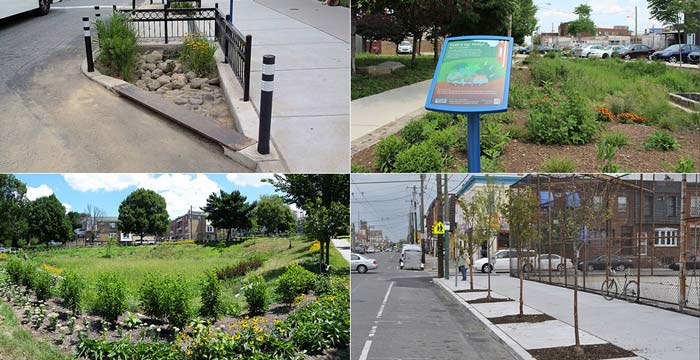
Philadelphia Water has kept HOW MUCH polluted water out of our waterways?
Clockwise from top left: A stormwater bumpout near the Universal Daroff Charter School in West Phila.; rain garden on E. Norris St. in East Kensington; stormwater basin at Kemble Park in North Phila.; stormwater tree trench on Snyder Ave. in South Phila.
Philadelphia Water is reaching a major milestone for our green infrastructure program, and we’re asking the people of Philadelphia to fill out a five minute online survey by March 28 that will help guide the future of our efforts to fight pollution in the city.
green city clean waters – where we are
This June will mark the five year anniversary of our groundbreaking agreement with state and federal regulators to take on the biggest source of pollution impacting our drinking water sources—stormwater and combined sewer overflows – with an unprecedented, massive green infrastructure program.
Called Green City, Clean Waters, the program was the first green-centric plan in the U.S. to gain acceptance from the Environmental Protection Agency, the federal regulator responsible for protecting the nation’s drinking water.
Before we signed that agreement in 2011, the generally accepted method of limiting urban stormwater pollution and sewer overflows on a large scale involved building big concrete storage tunnels to hold excess stormwater and expanding treatment plants to manage more water during storms.
Green City, Clean Waters also involves important upgrades to our Water Pollution Control Plants and building tunnels to hold stormwater. However, what makes it revolutionary is its “green first” approach to solving stormwater challenges: we’re relying on Green City, Clean Waters to do the bulk of the work by keeping water out of the sewer system in the first place.
what we’ve accomplished: Green City, Clean Waters 5 year anniversary
Over the last five years, we’ve developed procedures for designing and building Green City, Clean Waters like rain gardens and street tree trenches that use plants, soil and stone to capture, slow and filter the water that falls on our streets and buildings during storms.
And, while we all love nice round numbers, the Green City, Clean Waters five year anniversary is much more than that. In order to ensure that we’re moving toward a future with cleaner rivers, the EPA and the City of Philadelphia agreed to a set of specific goals to be achieved across the 25-year lifespan of the program. June 2016 marks the end what you might call our training wheels phase.
In regulatory documents, 2011-2016 is referred to as the “proof-of-concept” phase, “a period of growth, evolution and experimentation” designed to “provide time necessary to develop, expand, and establish the main components” of Green City, Clean Waters.
In other words, in the first five years, Philadelphia Water had to show (among other things) that we could build 744 “greened acres” – a term used to describe hard, water-repelling surfaces (like roofs and streets) in the city where stormwater is now managed with green tools. Before Green City, Clean Waters, those surfaces simply funneled polluted stormwater to overwhelmed sewers, leading to frequent overflows that put a mixture of diluted sewage and stormwater into our rivers.
We didn’t just meet that five year target. We came into 2016 with over 750 greened acres, a feat that means we’re now keeping over 600 million gallons of polluted water out of our rivers each year. And we’re doing that with systems that are making our neighborhoods greener, more vibrant places to live.
Goal: Next 5 years
We’ll be holding events this summer and fall to mark that accomplishment, but we’re also gearing up for the next five year target. It’s a big one. As you can see in the timeline below, Philadelphia Water must achieve an additional 1,401 greened acres (for a total of 2,148) by 2021- nearly three times what we’ve accomplished so far.
That’s why we want to hear from you. With the help of taking our short, five minute online survey by March 28th, we’re trying to understand the public’s knowledge and perspective on green stormwater infrastructure as we move towards the next (bigger) phase of Green City, Clean Waters. Familiarity with Green City, Clean Waters or green infrastructure is not required. We can’t meet our target for the next five years without your support.
Take the survey, and please share the link on social media. Together, we’re creating a future for Philadelphia with far cleaner rivers and far greener neighborhoods.
Photo Credit: Philadelphia Water






